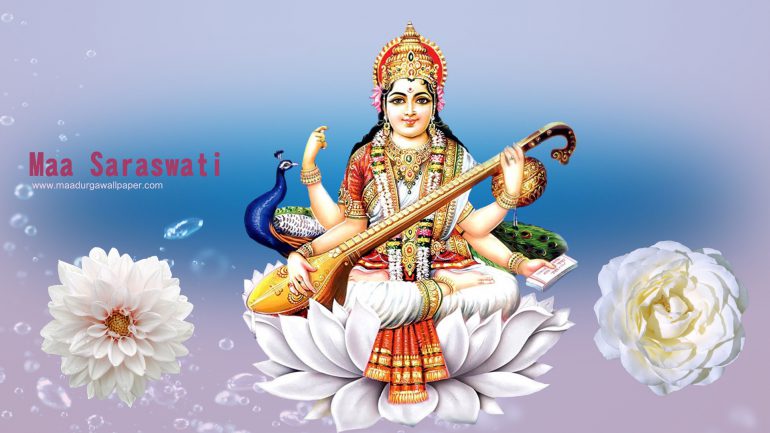Saraswati Jayanti, also known as Basant Panchami, is observed on the fifth day of the bright fortnight in the lunar month of Maagh (January-February) and is celebrated by Hindus worldwide. This naimittik karma is dedicated to the worship of Mother Saraswati. Saraswati Devi is the principle of the Divine that is associated with knowledge, speech and the fine arts. However, She is not limited to being the manifestation of all worldly knowledge but also represents knowledge in an infinite sense. Saraswati Devi signifies the enlightened intellect within us. She also signifies kriyaa shakti, the energy of activity, which allows the creative process to take place.
By the worship of Saraswati Devi, the devotee receives the light of wisdom, true knowledge, insight, intelligence and intellectual and creative brilliance. Such knowledge dispels the darkness of ignorance and frees one from the cycle of birth and death.
Symbolism associated with Saraswati Devi
The iconography of Saraswati Devi is usually white, from clothing to flowers to swan. White is the colour produced by reflecting all seven colours of light found in the visible spectrum; it symbolises sattva guna or purity of the mind. She holds a book that represents all areas of secular knowledge as well as an Akshamala that symbolises all spiritual knowledge or yoga. Thus, Saraswati represents knowledge at all levels, secular and spiritual. She is represented playing the veena (lute). It is said there are three states in listening to sound: gross, subtle and subtlest. When an instrument is played, the listener can hear the notes yet be totally detached from the composition of the notes – this is known as the gross level. The subtle level is the state where the listener is absorbed in the music whereas the subtlest level involves the listener becoming one with the music, that is, the listener seems to exist in the actual waveform and harmonics of the composition.
These three states can be extended from levels of listening to levels of reciting mantra jaap. The devotee can merely recite the mantra, while the mind strays elsewhere, similar to the gross level. The subtle level involves the devotee concentrating on the Divine while reciting the mantra. However, the states of devotee and Divinity still exist separately, that is, the state of duality. The subtlest level occurs when the devotee becomes one with the Divine and attains that state of non-duality. Saraswati Maa plays the veena at the subtlest level. Her depiction teaches us that in order to achieve an enlightened intellect, we must strive at practising the subtlest form of prayer and meditation.
Mother Saraswati is associated with two vahanas (vehicles), the peacock and the swan. The peacock with its beautiful plumage represents maayaa (illusion). This teaches us that we must transcend maayaa in order to become enlightened. There are stories that tell of the hamsa (swan) separating milk from a mixture of water and milk. Metaphorically, the swan represents vivek (the power of discrimination) whereby the devotee is able to differentiate between the real and the unreal. Thus, Saraswati Devi symbolises not only knowledge, but also discriminating knowledge with insight. If we are to rise intellectually, we must possess discrimination or be lost in the mundane state of ignorance. When one’s consciousness is at a heightened state of awareness, beyond the impure and worldly conditions of the mind, the attention then shifts to the changeless state, which is the true reality. The attainment of this ultimate state is the victory we achieve through worship of the Divine Mother.
A Metaphysical Perspective
From a metaphysical perspective, it should be noted that the Triveni in India comprises the Gangaa and Yamuna Rivers and the subterranean, mythical stream, Saraswati. Just as these three masses of water merge at Prayag, similarly, within the subtle body of man, three channels of bio-energy flow upwards from the Muladhaara chakra at the base of the spine and merge at the Ajna chakra, located in the forehead. These three channels of sustenance: the Ida Naadi, Pingala Naadi and Sushumna Naadi energise the entire body, fortifying it with the requisite energy to successfully carry out all bodily functions. Symbolically represented, Gangaa is representative of the Ida Naadi, the stream of bhakti or devotion; the subterranean stream Saraswati is symbolic of the Pingala Naadi, signifying gyaan, the stream of wisdom, while River Yamuna, the Sushumna Naadi, is representative of karma, the stream of selfless action. The worship of Saraswati Devi enables this flow of wisdom that takes one out of a state of ignorance to one of empowerment and self-realisation.



